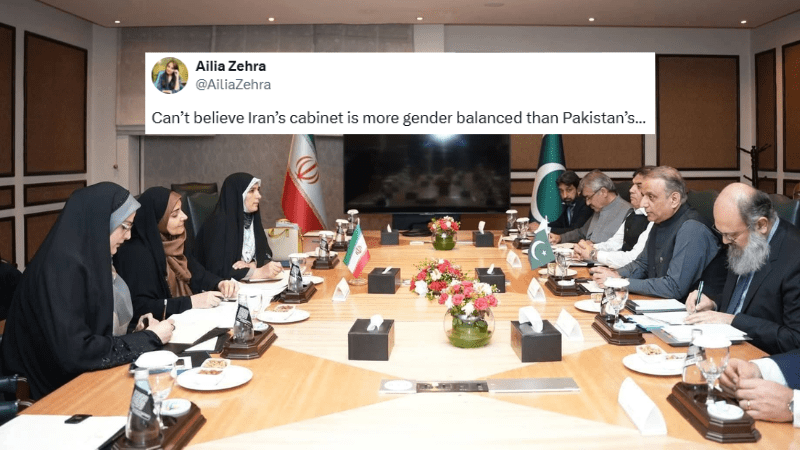A seemingly routine photo of a bilateral meeting between Iran and Pakistan has ignited a digital firestorm, and not for the reasons the Foreign Office might have anticipated.
Iran, which often faces the heat for its restrictive laws on women, sent Minister for Roads and Urban Development Farzaneh Sadegh to the negotiation table. While Sadegh was accompanied by two other women in her delegation, the Pakistani side showcased a male-only team.
An image showing Sadegh seated across a row of six Pakistani male officials, including Pakistan’s Federal Ministers for Communications Abdul Aleem Khan, Commerce Jam Kamal Khan, and Railways Hanif Abbasi, has gone viral on X.
What was meant to mark a promising step forward in regional connectivity through initiatives like the Gwadar-Chabahar route and the revival of the Islamabad-Tehran-Istanbul railway has instead become a stark visual reminder of the glaring absence of Pakistani women in positions of power.
“Can’t believe Iran’s cabinet is more gender balanced than Pakistan’s,” wrote one user.
“It would come as a surprise to many, but Iran is more progressive than us. A true conservative culture. Not vile and extremist,” added another.
For a country that considers itself more “moderate” or “secular” than its neighbour, the optics are damning. “Such a sad picture for a country which considers itself more secular than Iran,” said one user.
Others were quick to highlight that moments like these are becoming all too common.
“You almost never see Pakistani women leading in any of these government-level meetings with other countries. The last time something visible was when [Benazir Bhutto] was the PM or during PTI’s time with the likes of Shireen Mazari, Sania Nishtar, etc.”
As important talks are held about trade corridors, transport modernisation, and regional integration, women, who make up nearly half the population, are systematically shut out from the very tables where their futures are being decided.
Pakistan, a country that takes pride in having had a female prime minister long before many Western democracies — the late Benazir Bhutto — now finds itself in the uncomfortable position of being outpaced by Iran when it comes to female political representation.
The absence of women from high-level negotiations not only undermines Pakistan’s image on the global stage but also raises serious concerns about the inclusivity of policymaking.
“The West and Zionist-controlled media will never show you this,” wrote one user, highlighting how Iran’s perceived conservatism is often overblown in global media narratives.
“But saar, Iranian women are not allowed to work in government, their life is hell, maybe these women are from another planet,” quipped another.
The Iranian cabinet has three women ministers at the moment. Pakistan currently has one woman serving as a federal minister and two ministers of state. But that’s not enough.
This meeting, meant to celebrate regional cooperation and economic ambition, has unintentionally turned into an embarrassing moment for Pakistan as well as a reminder that progress isn’t just about trade routes and railway lines, but also about who gets to help chart them.
Until women are routinely present at tables of power, not as anomalies, but as equals, talk of progress may remain just that — talk.
